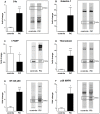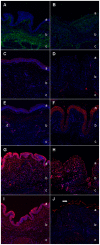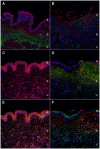Novel potential interacting partners of fibronectin in spontaneous animal model of interstitial cystitis
- PMID: 23236492
- PMCID: PMC3517491
- DOI: 10.1371/journal.pone.0051391
Novel potential interacting partners of fibronectin in spontaneous animal model of interstitial cystitis
Abstract
Feline idiopathic cystitis (FIC) is the only spontaneous animal model for human interstitial cystitis (IC), as both possess a distinctive chronical and relapsing character. Underlying pathomechanisms of both diseases are not clearly established yet. We recently detected increased urine fibronectin levels in FIC cases. The purpose of this study was to gain further insight into the pathogenesis by assessing interacting partners of fibronectin in urine of FIC affected cats. Several candidate proteins were identified via immunoprecipitation and mass spectrometry. Considerable changes in FIC conditions compared to physiological expression of co-purified proteins were detected by Western blot and immunohistochemistry. Compared to controls, complement C4a and thioredoxin were present in higher levels in urine of FIC patients whereas loss of signal intensity was detected in FIC affected tissue. Galectin-7 was exclusively detected in urine of FIC cats, pointing to an important role of this molecule in FIC pathogenesis. Moderate physiological signal intensity of galectin-7 in transitional epithelium shifted to distinct expression in transitional epithelium under pathophysiological conditions. I-FABP expression was reduced in urine and urinary bladder tissue of FIC cats. Additionally, transduction molecules of thioredoxin, NF-κB p65 and p38 MAPK, were examined. In FIC affected tissue, colocalization of thioredoxin and NF-κB p65 could be demonstrated compared to absent coexpression of thioredoxin and p38 MAPK. These considerable changes in expression level and pattern point to an important role for co-purified proteins of fibronectin and thioredoxin-regulated signal transduction pathways in FIC pathogenesis. These results could provide a promising starting point for novel therapeutic approaches in the future.
Conflict of interest statement
Figures





Similar articles
-
Follow-up protein profiles in urine samples during the course of obstructive feline idiopathic cystitis.Vet J. 2013 Dec;198(3):625-30. doi: 10.1016/j.tvjl.2013.09.015. Epub 2013 Sep 21. Vet J. 2013. PMID: 24257070
-
Decrease of Trefoil factor 2 in cats with feline idiopathic cystitis.BJU Int. 2011 Feb;107(4):670-7. doi: 10.1111/j.1464-410X.2010.09500.x. BJU Int. 2011. PMID: 20636394
-
Beyond neurons: Involvement of urothelial and glial cells in bladder function.Neurourol Urodyn. 2010;29(1):88-96. doi: 10.1002/nau.20747. Neurourol Urodyn. 2010. PMID: 20025015 Free PMC article.
-
Feline Idiopathic Cystitis: Pathogenesis, Histopathology and Comparative Potential.J Comp Pathol. 2021 May;185:18-29. doi: 10.1016/j.jcpa.2021.03.006. Epub 2021 Apr 16. J Comp Pathol. 2021. PMID: 34119228 Review.
-
Comorbidity of interstitial cystitis with other unexplained clinical conditions.J Urol. 2004 Oct;172(4 Pt 1):1242-8. doi: 10.1097/01.ju.0000137953.49304.6c. J Urol. 2004. PMID: 15371816 Review.
Cited by
-
Research Findings on Overactive Bladder.Curr Urol. 2015 May;8(1):1-21. doi: 10.1159/000365682. Epub 2015 May 20. Curr Urol. 2015. PMID: 26195957 Free PMC article. Review.
-
Exploring the anti-inflammatory effects of phytochemicals in attenuating interstitial cystitis-a literature review.Front Pharmacol. 2025 Feb 5;16:1483548. doi: 10.3389/fphar.2025.1483548. eCollection 2025. Front Pharmacol. 2025. PMID: 39974737 Free PMC article. Review.
-
Molecular effects of intermittent stress on primary feline uroepithelial cell culture as an in vitro model of feline idiopathic cystitis.Front Vet Sci. 2023 Nov 6;10:1258375. doi: 10.3389/fvets.2023.1258375. eCollection 2023. Front Vet Sci. 2023. PMID: 38026670 Free PMC article.
-
Evaluating feline lower urinary tract disease: Doppler ultrasound of the kidneys.J Feline Med Surg. 2023 Jan;25(1):1098612X221145477. doi: 10.1177/1098612X221145477. J Feline Med Surg. 2023. PMID: 36649073 Free PMC article.
-
Prevalence, Risk Factors, Pathophysiology, Potential Biomarkers and Management of Feline Idiopathic Cystitis: An Update Review.Front Vet Sci. 2022 Jun 21;9:900847. doi: 10.3389/fvets.2022.900847. eCollection 2022. Front Vet Sci. 2022. PMID: 35812890 Free PMC article. Review.
References
-
- Westropp JL, Buffington CA (2002) In vivo models of interstitial cystitis. J Urol 167: 694–702. - PubMed
-
- Lavelle JP, Meyers SA, Ruiz WG, Buffington CA, Zeidel ML, et al. (2000) Urothelial pathophysiological changes in feline interstitial cystitis: a human model. Am J Physiol Renal Physiol 278: F540–553. - PubMed
-
- Buffington CA, Chew DJ, Woodworth BE (1999) Feline interstitial cystitis. J Am Vet Med Assoc 215: 682–687. - PubMed
-
- Nordling J, Fall M, Hanno P (2011) Global concepts of bladder pain syndrome (interstitial cystitis). World J Urol. - PubMed
Publication types
MeSH terms
Substances
LinkOut - more resources
Full Text Sources
Medical
Research Materials
Miscellaneous

